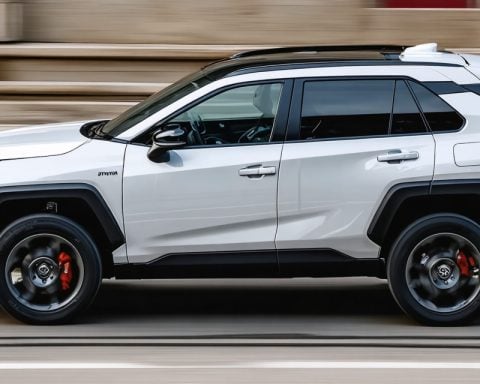A New Dawn for City Traffic: The world may soon look at traffic in a whole new way as Tesla accelerates towards full vehicle autonomy with its latest Full Self-Driving (FSD) software updates. This technological breakthrough could redefine our daily commutes and sculpt a fresh landscape for urban mobility.
Revolutionizing City Commutes
Imagine a city where cars are not just vehicles, but active participants in a smart network designed to ease congestion and lower emissions. With Tesla’s recent FSD enhancements, this vision edges closer to reality. These updates range from automated lane adjustments to traffic light recognition, paving the way for a seamless urban navigation experience that promises reduced stress, quicker commutes, and heightened road safety.
Challenges Along the Road
Despite these advancements, the journey to embracing such autonomy includes overcoming significant challenges. Regulatory frameworks worldwide must evolve to accommodate these innovations, ensuring safety without stifling progress. Ethical questions, such as how AI should act in difficult situations, need comprehensive discussions to align with societal values.
Embracing the Future
The advantages are undeniable. Autonomous vehicles offer unparalleled convenience, boost road safety, and hold the potential for sustainability advancements through efficient driving. Yet, gaps remain, notably in technology’s current state and public acceptance. Ensuring robust cybersecurity and compatibility with prevailing traffic systems is critical to their successful integration.
Are We There Yet?
As Tesla continues to refine its technology, we edge closer to a future where city traffic transforms into a harmonious ecosystem, promising unprecedented freedom and efficiency in urban life. It’s a paradigm shift poised to redefine our interaction with mobility forever.
The Green Impact of Autonomous Vehicles
Tesla’s push towards full vehicle autonomy, marked by its latest Full Self-Driving (FSD) software updates, promises not just a breakthrough in urban mobility but also significant implications for the environment. The integration of autonomous vehicles (AVs) into daily commutes could mark a pivotal shift in reducing carbon footprints, minimizing pollutants, and fostering a more sustainable future.
Environmental Benefits
Autonomous vehicles are poised to redefine urban landscapes with their potential to drastically cut down on emissions. Equipped with advanced navigation systems designed to optimize routes and reduce idling, these vehicles can significantly decrease the amount of fuel consumed and the pollutants released into the atmosphere. As AVs become more prevalent, we may witness a reduction in urban air pollution, contributing to healthier living conditions and mitigating the urban heat island effect.
Additionally, the transition toward electric autonomous vehicles could further enhance environmental benefits. By shifting away from traditional gasoline-powered engines to electric drivetrains, cities can reduce their reliance on fossil fuels. This shift would not only lessen the environmental degradation associated with oil extraction and refining but also promote cleaner energy usage, aligning with global goals for reducing greenhouse gas emissions.
The Human Aspect
From a human perspective, the environmental advancements related to AVs bring forth broader implications for public health. Reduced emissions translate to cleaner air, potentially decreasing respiratory problems and improving overall community health. Furthermore, the reduced traffic congestion attributed to smarter, autonomous traffic systems could lead to fewer accidents and subsequent health risks, enhancing the quality of urban life.
Economic Insight
Economically, the transition to autonomous vehicles offers opportunities for new industries and job creation, particularly in sectors related to sustainable technology, electric vehicle production, and AI development. Investments in greener infrastructures, such as expanding charging networks and smart traffic systems, could revitalize urban areas and support eco-friendly economic growth.
However, as cities transition, there is a need to address the economic displacement in traditional sectors, like those of conventional vehicle manufacturing and fossil fuel industries. Fostering a green economy that supports those affected by such a paradigm shift will require policy interventions and targeted investments in retraining and reskilling the workforce.
Future Connections
As humanity steps into this era of autonomous transportation, the connection between technological innovation and environmental stewardship becomes ever more apparent. By harnessing the potential of AVs, cities worldwide can set a precedent for sustainable urban planning, encouraging the adoption of technologies that prioritize the planet’s well-being. This transition could inspire global initiatives toward sustainable living, highlighting how technology can be aligned with ecological priorities to foster a livable, green future for generations to come.
In summary, Tesla’s advancements in autonomous vehicle technology herald not only a transformation in how we navigate urban spaces but also a meaningful stride toward environmental sustainability. This shift may redefine how society interacts with transportation, offering an opportunity to build a cleaner, healthier, and more resilient world.
Is Tesla’s Full Self-Driving the Answer to Urban Traffic Woes?
The development of Tesla’s Full Self-Driving (FSD) software presents a transformative potential for city traffic dynamics. This growing technology could not only redefine how we perceive urban mobility but also set new standards for vehicle autonomy on a global scale.
Trends in Autonomous Vehicle Adoption
Globally, there is an increasing interest in autonomous vehicles, with many urban centers exploring smart transportation grids. Regions like Europe and North America are particularly investing heavily in infrastructure that supports autonomous technologies, driven by urbanization challenges and the push for greener transport solutions.
Innovations with Tesla’s FSD Updates
Tesla has introduced several innovative updates in its FSD package, designed to advance the integration of self-driving capabilities into everyday commutes. Notably, the enhanced traffic light recognition system and refined automated lane adjustments furnish vehicles with the capacity to navigate complex urban environments more autonomously.
In future iterations, Tesla is expected to enhance vehicle-to-vehicle (V2V) communication, which would allow cars to exchange data and make real-time decisions, further optimizing traffic flow and reducing congestion.
Pros and Cons of Autonomous Urban Mobility
Pros:
– Reduced Congestion: By optimizing traffic flow, autonomous vehicles can significantly lower congestion levels in urban areas, leading to faster and more predictable commutes.
– Environmental Benefits: More efficient driving patterns can result in lower emissions and better fuel economy.
– Safety Improvements: With continuous data analysis and decision-making capabilities, the potential for accidents due to human error is significantly reduced.
Cons:
– Regulatory Hurdles: Existing laws and transportation regulations need significant updates to accommodate and govern autonomous driving technology effectively.
– Ethical Dilemmas: AI-based decision-making in complex traffic situations raises ethical questions that society must address.
– Technology Limitations: Current AI systems possess limitations in real-time decision-making, especially in unforeseen scenarios or extreme weather conditions.
Security Aspects and Compatibility Concerns
Ensuring the cybersecurity of autonomous vehicles is critical as they become more ingrained in our transport systems. Protecting against hacking attempts and ensuring secure software updates are challenges that manufacturers like Tesla must continue to address.
Compatibility with existing traffic systems remains a concern, requiring cooperation between automotive engineers, urban planners, and government bodies to ensure a smooth integration of autonomous vehicles.
Market Analysis and Predictions
The autonomous vehicle market is set for exponential growth, with Tesla confidently positioned as a leader due to its advanced FSD system. The broader transport market can anticipate a substantial shift towards electric and autonomous modes of commuting in urban centers worldwide.
Embracing Sustainable Urban Transport
The rise of autonomous vehicles is positioned as a crucial pillar in smart city development, with the potential to foster cleaner, more efficient, and safer urban environments. As cities evolve, Tesla’s advancements in self-driving technology bring us closer to realizing the vision of sustainable and congestion-free urban mobility.
For further updates on Tesla’s innovations and electric vehicles, visit their official website.













